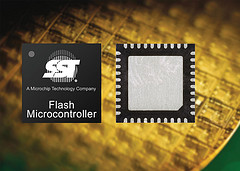The words no engineer or supply chain professional wants to hear: end-of-life. It’s a reality of the semiconductor business, however – even the cheapest parts reach the point, eventually, where producing and selling them becomes inefficient. Is it reasonable that a microcontroller architecture outlive the people who designed it in?
 Today’s press release from Microchip is a great example. NXP has recently EOLed most of their family of 80C51 MCUs, sending engineers scrambling. (One forum post: “I have 15 designs using this.”) Microchip, through their purchase of Silicon Storage Technology (SST), finds themselves still in the 80C51 business, and has pin-for-pin replacements.
Today’s press release from Microchip is a great example. NXP has recently EOLed most of their family of 80C51 MCUs, sending engineers scrambling. (One forum post: “I have 15 designs using this.”) Microchip, through their purchase of Silicon Storage Technology (SST), finds themselves still in the 80C51 business, and has pin-for-pin replacements.
The specter of EOL goes well beyond the MCU hardware and PCB design, however. Changing the MCU means blowing up the software – which there is a good chance nobody really understands the code right now, in some cases decades after the initial release – and facing the prospect of recertification in an application such as a medical or industrial device. Both are expensive propositions.
I vividly remember a project in my engineering days, where two of my friends worked magic with a pile of Altera programmable parts to replace a pair of 1802s, creating a microcode engine that would run the application software binary with no changes. It was hailed as a miracle, that we could take control of the risk that the 1802 would go EOL and person-years of software would vaporize with it. (Holding a patent that modified that software, I can tell you firsthand it was ugly.)
The 8051 architecture has been IP cored, maybe more than anything outside of ARM. A drop-in part for an EOL device is nice, but more likely over time engineers will have to take control of their risk and build their own MCU if they want to preserve the 8051 code. It’s a shift in thinking that requires some “new” (to the designer at least) EDA design tools and skills. There’s 8051 core IP from folks like CAST, Dolphin, IPextreme, Mentor, and Synopsys, and peripheral IP and tools to help produce custom parts.
The alternatives are to wait for the devices in production to die off, completely, including any repair commitments, or to migrate the software to something newer, which eventually faces the same problem but hopefully not for a couple decades. I chuckled when I read in a forum that the ARM Cortex-A9 is overkill for the applications 8051s are popular in – yes, but consider the Cortex-M0 or -M4 available from many manufacturers. Microchip is of course hoping their 8051 customers move into the PIC family.
The premise behind a move is to move as far forward as you can within the power, cost, and risk parameters. If you’re trying to create a new design with more flexibility, changing architectures may be the right answer, but the option of designing a part can be compelling.
I’m guessing we’ll still be writing about 8051 designs in 10 years, but many more will be core IP custom designs.
Share this post via:








Quantum Computing Technologies and Challenges